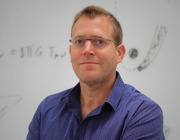My research Interests include a variety of subjects such as ultra-long gamma-ray bursts, supernovae rates, gravitational lensing, galaxy evolution and more. Currently, my research is mainly (but not only) conducted in the field of time domain astronomy with a focus on radio astronomy. Below are descriptions of some of my current interests.

Time-domain astronomy has experienced a renaissance during this recent decade. This field encompasses explosive transients, variable sources, and moving objects. Thanks to the advent of synoptic optical facilities, the field of time domain astronomy is undergoing fantastic growth. The main goal of our observational research group at HUJI is the observational study of many types of cosmic explosions. While we study them in various wavelengths (including optical and Xray) our focus is on exploring them in radio waves (since radio observations provide unique diagnostics as they trace high-energy particles and magnetic fields), using several large telescopes around the world.

The richness of cosmic explosions and thus of our research topics is large: 1. Supernovae - These are the explosive deaths of massive stars (see figure [a] for illustration). In our supernova study, we aim at characterizing some of the physical processes taking place at the explosion (such as shockwave properties) and link them to the properties of the progenitor star prior to the explosion. By doing so, we are building an empirical understanding of the last stages of stellar evolution leading to stellar death. 2. Tidal disruption events - When a star passes too close to a supermassive black hole, it might be torn apart by tidal forces (see figure [b] for illustration). This phenomenon is still not well understood but leads to a flash of light when it occurs.

In our observations of this transient phenomenon we address several key open questions in this field, such as, are relativistic jets launched and why? And what happens to the stellar debris? In parallel, this phenomenon allows us to probe the environment in the close proximity around black holes, a capability which is currently not possible in any other way. 3. New types of explosions - In our research we observe, characterize and study new types of cosmic explosions, such as fast luminous optical transients. So far, with respect to this and other new and rare transient phenomena, we only found the tip of the iceberg, and working towards unveiling their nature. 4. New frontiers - The discovery of gravitational wave events and of an electromagnetic counterpart associated with one of the events (our group was part of the discovery team; see an illustration of the moving outflow based on our research in figure [c]), has opened a new era of multi-messenger astronomy. Moreover, the radio astronomy field has seen tremendous developments over the last decade with the inauguration of new radio facilities which enables advanced and novel scientific research. Our group at HUJI is involved in several key scientific research programs centered on these new fields. Students (both graduate and undergraduate) are welcome to apply for research student positions in our group. In addition to performing their own research, students in the group will have the opportunity to gain experience in working with several major telescopes worldwide and will also participate in top international collaborations in astrophysics.


